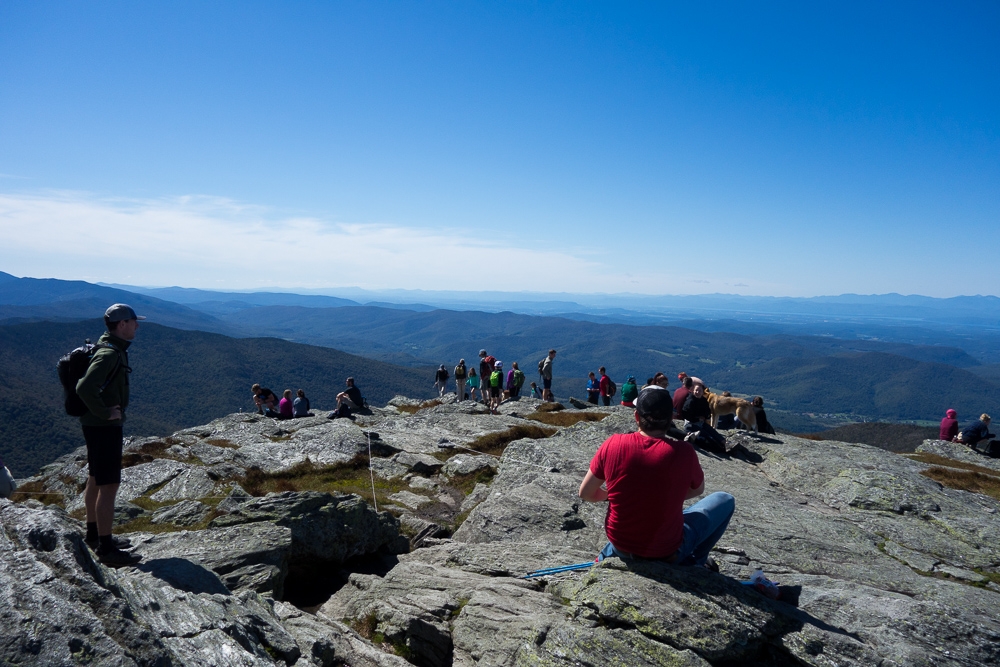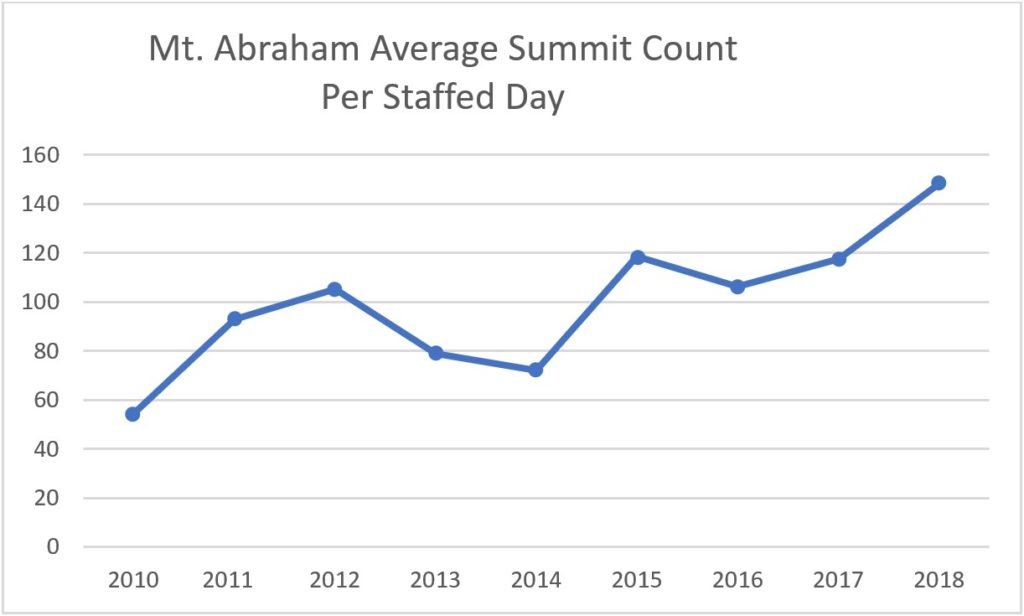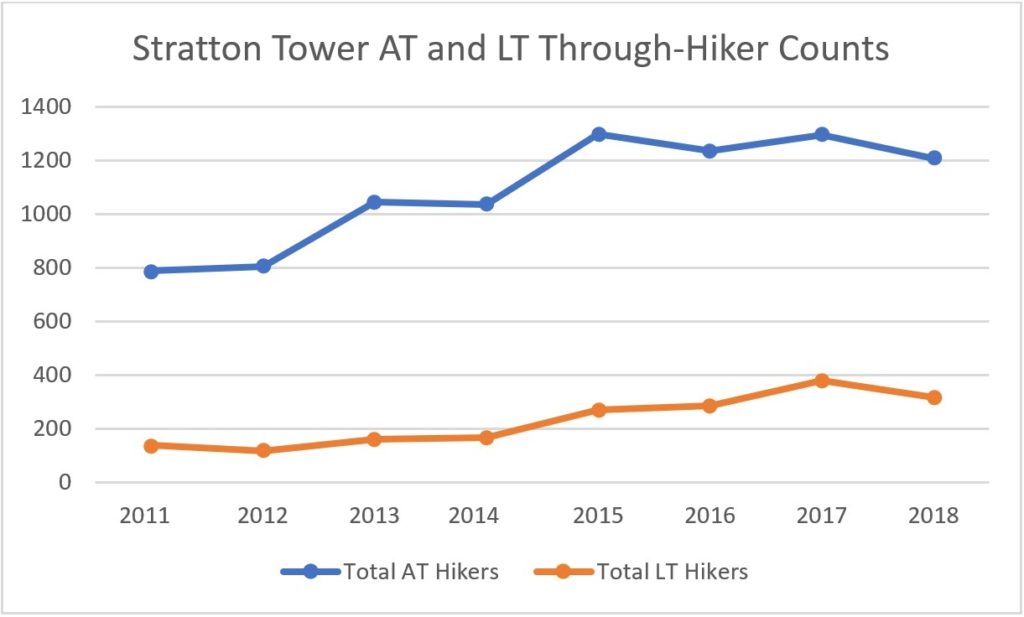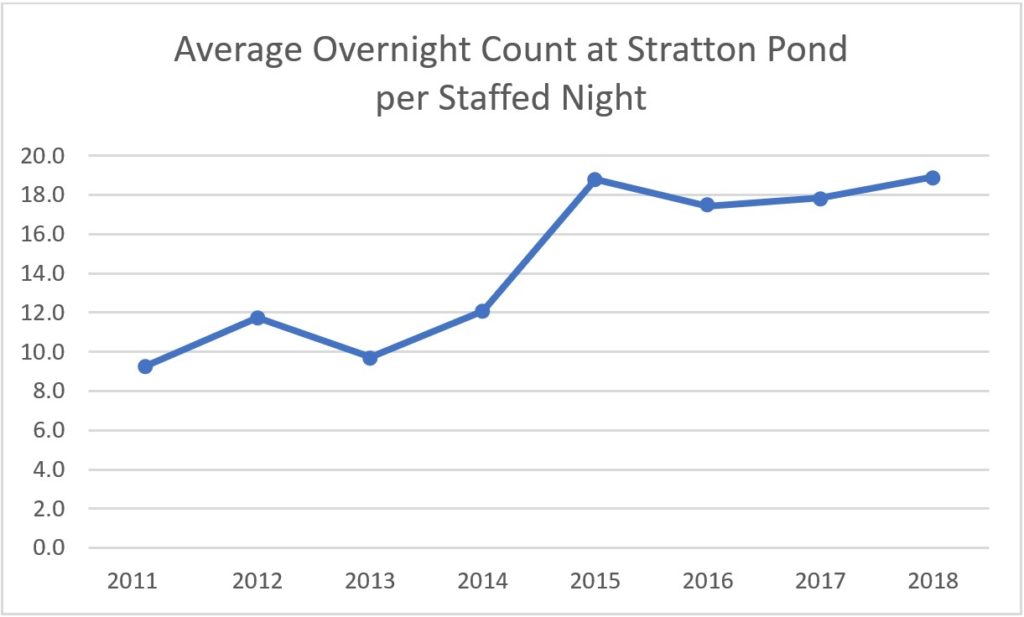
If you’ve spoken to a Green Mountain Club caretaker while they’re on a summit, you may have noticed them clicking a small hand-held counter. The “clickers,” as we call them, are used to count how many individuals come up to the summit while the caretaker is there. The count spans an entire day’s shift, and the clicker is handed off like a baton when the caretakers trade posts. If you’ve stayed at a caretaker-staffed overnight site, you may have seen the caretaker filling out their weekly record of overnight guest numbers, carefully tallying the numbers of people tenting, people in the shelter, and members of organized groups. The summit and overnight counts are compiled each week in a report and submitted to GMC’s field office.
Once at the office, the counts are added to tables of data stretching back over years of counting. We use these tables to determine which weekends need extra summit staffing, which privies (outhouses) will need the most work, and so on. We also use the data to see developing trends, which helps us predict events such as 2015’s record-breaking totals on Mount Mansfield and Camel’s Hump. Tracking trends also help us plan projects for where they’re needed most, such as installing a second privy at Stratton Pond Shelter.
Numbers across the east coast show increasing use of hiking trails and overnight sites throughout the Long Trail and Appalachian Trail, as well as in the Adirondacks. What do we mean by increased use? Before 2009, we had only one year in which Mount Mansfield caretakers counted more than 40,000 visitors on the ridgeline in a season. Since then, we haven’t had a single year with a ridgeline count less than 40,000. For overnight sites, increased use means a rising average of people staying at shelters or tenting areas each night.
Below are some examples of the kinds of charts we make to analyze summit visitation.
Because the Mount Abraham caretaker only staffs the summit on weekend days and fair-weather weekdays, we use an average count instead of a total to track trends. In order to ensure we are tracking impact, we include dogs and babes-in-arms in our visitor counts.

On Stratton, we count not only the total number of visitors but also the number of Appalachian Trail and Long Trail thru-hikers. The summit caretaker asks hikers in person most days and uses the summit register box to find the numbers for the other days. These numbers include section hikers, as well as thru-hikers who do not make their goal.

Because many of our caretaker sites are staffed five nights a week or have occasional gaps in coverage, we use an average overnight count instead of a total to track trends at sites like Stratton Pond. For sites with overflow tenting or camping areas, like Stratton Pond Shelter and Stratton View Tenting Area, we combine the satellite and main overnight site data.

What does this mean?
These numbers translate to real-world impacts on the trail, its surrounding environment, and those who use it. A higher average number of people at a shelter means more campers will choose to use tents, which widens the impacted area around a shelter. It means multiple campfires, and therefore a wider area cleared of brush and debris. On steep trails, more hikers mean more erosion from tired feet. On summits, increased use means bigger crowds spreading out over fragile alpine areas to find a seat or take photos.
Our job in Field Programs is to keep the trails, shelters, and tenting areas up to the task of absorbing these impacts. We are planning to do more educational outreach on summits and at ponds. At the same time, we need our caretakers to be able to complete their trail and privy maintenance responsibilities, which means we need to add more caretakers to handle the higher demand for summit and pond conversations. We are planning to deploy more trail crews to those trails which have seen the most impact, such as the Burrows and Monroe Trails on Camel’s Hump and the Sterling Pond Trail in Smugglers’ Notch. These crews must be in addition to our more routine work, meaning we will be hiring more seasonal Long Trail Patrol and Volunteer Long Trail Patrol employees in the coming years.
Green Mountain Club members have supported Vermont’s trails since 1910. Although membership has remained steady through recent years at around 9,500 members, we have been counting over 200,000 trail users per hiking season. Membership is becoming increasingly important as we look to grow our programs and better support the trail and manage for the increased use we are seeing. If you haven’t already, will you join the adventure and join GMC to help support and protect the trails?



















Thank you for compiling the field usage for the 2018 hiking season. Clearly your static’s show that only 4.75% of users are GMC members. Perhaps shelter caretakers and summit stewards should ask users if they are members and if the reply is no, they should be encouraged to join the GMC. Perhaps flyers should be handed out which provide information on how to join. Or better yet could shelter caretakers or summit stewards get peopl to sign up to become members right then and there. Another suggestion would be to set up a table in a high use parking lot on a high traffic day and get users to join the GMC or at least to provide information on how to become a member. Thanks for considering my suggestions and thanks for all your hard work in protecting the trail!